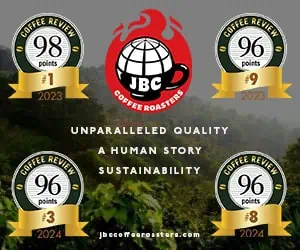In the new world of high-end specialty coffee, botanical variety of the tree has become one of the crucial ways to differentiate and describe small lots of fine coffee. Grape variety has long been a differentiator in wine, of course, and increasingly dominates description and selling of certain fruits and vegetables. But botanical variety also has become an increasingly intensely explored path to higher return and more recognition for producers and roasters of coffee.
This month we tested thirty-one such small-lot coffees, each produced only from a single botanical variety of Arabica. In many cases these small lots had been subjected to special, customized fruit removal and drying, particularly drying in the whole fruit. Given the care that was lavished on these small lots, it is no surprise that as a group they attracted such high ratings: twenty of the total of thirty-one coffees we tested rated 90 or higher. Thirteen of the very highest rated, with scores ranging from 92 to 95, are reviewed this month. A few of these rare and obsessively prepared coffees are dauntingly expensive, but most are in fact modestly priced when one weighs their cost against their distinctiveness and the meticulous effort that went into their production.
Single-Variety Incentives
Most varieties of arabica are not intrinsically distinctive or different in the cup. Most were selected or developed for agricultural reasons (higher yield, better pest or disease resistance) or simply planted out of convenience or tradition. With the most common varieties grown in the world the impact of terroir (soil, growing elevation, climate) and fruit removal and drying methods tend to blur any fine distinctions the tree variety brings to the cup. Hence there is usually no commercial advantage to the farmer to separate out varieties.
But if beans from a certain variety taste different enough and look different enough from typical beans there are incentives to the grower to isolate them and market them separately from other varieties produced on the farm, incentives that include higher prices and greater insider recognition.
The Rock-Star Varieties
It is no surprise, then, that most of the thirteen coffees reviewed this month were produced from trees of varieties that are particularly known for their distinctiveness in the cup: Gesha, Pacamara, Maracaturra, and Ethiopian heirloom varieties. Most of these distinctive-tasting varieties also are recognizable visually by the distinctive look of their beans, whether it is the giant beans of the Pacamara and Maracaturra varieties, the largish boat-shaped beans of the Gesha, or the small, roundly oval beans of Ethiopian heirloom varieties with their characteristically prominent, often silver-skin-filled center creases.
Regrettably, perhaps, given how outrageously pricy it can be, the rare Gesha or Geisha variety, with its unique and soaring floral and crisp cocoa-toned aromatics, supplied four of this month’s six highest (94- to 95-) rated samples. The big-beaned Pacamara variety, a taste-successful hybrid of the giant-beaned Maragogipe and the compact-growing Pacas varieties, supplied the other two samples that rated 94 or higher. Two additional high-rated (93 and 92) samples came from the Maracaturra variety, a variation on the Pacamara that crosses the Maragogipe with the sturdy, compact-growing Caturra.
Unlike the recently rediscovered Gesha and the relatively recently developed Pacamara and Maracaturra hybrids, the three high-rated Ethiopia coffees in this month’s set of top-rated samples come from varieties of Arabica that stretch far back into history. The Evans Brothers Organic Yirgacheffe Aylele (93), Café Virtuoso Ethiopia Worka (92), and Bonlife Ethiopia Tswana (92) all were produced from trees of heirloom varieties native to Ethiopia, coffee’s original home, varieties that the Ethiopian coffee authorities wisely have protected against dilution from imported seed.
In terms of sensory character, the four varieties that dominated this month’s reviews split neatly into opposing pairs. On one hand are the extravagant floral, citrus and cacao fireworks of the Ethiopia-derived Gesha and the similar though less intense flowers and citrus of the heirloom Ethiopias. On the other are the deep, resonant, savory-sweet complexities of the Pacamara and Maracaturra. The Pacamara and Maracaturra appear considerably less predictable in their distinctive character than the Gesha and Ethiopias, by the way; both Pacamaras and Maracaturras, given farm and year, can lapse into good though ordinary coffees. Neither the Gesha nor the Ethiopias always awe us either, though they remain reassuringly recognizable despite the vagaries of year and the impact of terroir.
A Bourbon, a Revival and a Discovery
Others among this month’s high-rated samples tended to come from distinguished though less predictably distinctive varieties. The ancient, heirloom Bourbon variety showed up in several samples. Only one popped to 92 or higher, however, the Topéca El Manzano Bourbon Natural (93), though its gently pungent complexity perhaps owes as much to a tactful “natural” or dried-in-the-fruit processing as it does to the intrinsic character of the Bourbon beans.
Two of the most unusual varieties reviewed this month represent efforts by producers to recover older varieties of Arabica that have been overlooked or obscured by later developments. Hula Daddy, an innovating producer from Kona, Hawaii, is reviving a strain of an “old” Typica that historically preceded the Guatemala strain of Typica that still dominates Kona coffee production today. Hula Daddy calls this early, nineteenth-century strain “Brazil Typica,” although some of the early Typicas in Kona apparently came from Java as well as from Brazil. Wherever the plant material originated, in the meticulous, spare-no-care hands of Hula Daddy this venerable strain has produced an impressively classic coffee, a Kona-style coffee on steroids: deep, gently tart, lush (93).
Wahana Estate in Sumatra has been innovating ever since its founding in 2005. Home Barista Workshop, a tiny, progressive roaster in Taiwan, sent a sample of a Wahana Estate variety that closely resembles certain Ethiopia varieties generally called “longberry Harrar.” These Ethiopia varieties produce beans with an extended oval shape and a center crease that tends to stubbornly retain the whitish residue of the silverskin. Whether this Wahana Estate version (92), found growing in Aceh in Sumatra, is indeed a clear carryover from Ethiopia plant material remains to be determined, but the beans do seem very, very close in appearance to similar beans from Ethiopia, and the cup character, while not immediately and strikingly Ethiopian, is quite unusual. With its antique-looking beans, chocolate-toned richness, sweet flowers and gentle strawberry tartness, this is a variety that definitely deserves further attention.
Processing and the New Naturals
Of the thirteen samples we reviewed this month, seven were processed by variations of the traditional wet or “washed” method, in which the soft residue of the fruit is removed from the beans before they are dried. One of the thirteen, the CaféTaster Finca Santa Teresa Geisha (94), was processed by the “honey” method, wherein the skin of the fruit is removed but the beans are dried with all or part of the fruit flesh, or honey, still adhering to them. Five of the thirteen samples, however, were dried by variants of the dry or “natural” method, wherein the beans are dried inside the whole fruit.
Even three years ago, most such dried-in-the-fruit coffees displayed a heavy, sweetly brandy-like fruit that some purists condemned, but which many coffee lovers found deeply appealing. Admirers of this fruity “new natural” type enjoyed the sweetly fermenty fireworks in front and were willing to forgive a salty, bitterish finish that often developed in these coffees as the cup cooled. Over the past four or five years we at Coffee Review did our best to identify for our readers those dried-in-the-fruit coffees that showed the sweet, fermenty fruit they enjoyed, but which also finished cleanly, with minimum salt and bitterness. One such win-win fruit-and-brandy natural appears in this month’s reviews, the classically brandy-and-blueberry-toned Café Virtuoso Ethiopia Worka (92).
The New, New Naturals
Over the past two or three years, however, some innovating producers have managed to dry coffee in the fruit while provoking very little fermentation in the sugars during drying, thus reducing the extravagant fermenty fruit notes but in the process generally refining and lightening the aromatics and minimizing the salty bitterness in the finish. Aside from the Café Virtuoso Ethiopia Worka, all of the naturals reviewed here represent variations on this new, refined style of dried-in-the-fruit profile, including the top-rated Papa Lin Panama Gesha Perci Red, in which a very controlled, tactful drying in the fruit appears to encourage a version of the Gesha flower, cacao and citrus cup deeper and more resonant than is typical with a wet-processed version.
These new, new naturals are typically impressive coffees, their success a tribute to the persistence and commitment of the producers. However, if you are one of those coffee drinkers who enjoy the older-fashioned, heavier, fruitier, more brandy-toned style of dried-in-the-fruit coffee, go ahead and defy the purists, buy a coffee like the Café Virtuoso Ethiopia Worka, and enjoy it. After all, in specialty coffee diversity as well as excellence rules, and diversity is what we all are after when we pursue the excitement of exotic varieties and the nuance of new processing variations.
2013 The Coffee Review. All rights reserved.











